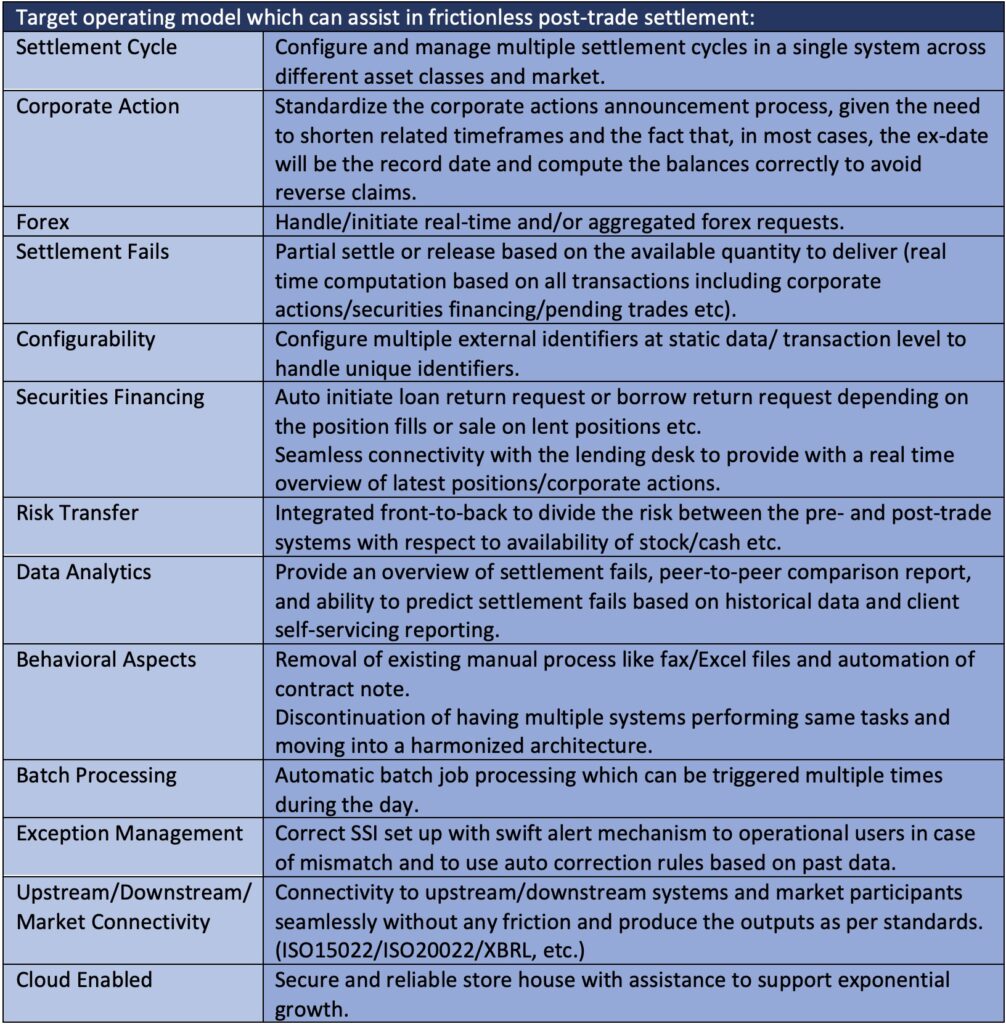In a quest to reach more efficient securities settlement, buy- and sell-side firms face immense pressure to update their systems and remove expensive manual processes. These forces are exacerbated for European firms with the Central Securities Depositories Regulation (CSDR) penalty regime, which has imposed penalties of over two million euros per month for some settlement failures. With T+1 on the horizon, join Kamal Kannan, Director, S&P Global Market Intelligence, for a closer look at why firms should be systems and process ready to face the regulatory change.
By Kamal Kannan
This is the full version of the article.

The North American markets’ proposals to move towards a shorter settlement cycle are adding fuel to the fire. Other markets are already on a shorter cycle, such as India, which has already moved to T+1 on a phased approach, starting with its most illiquid instruments, while Hong Kong and China are settling cash equities on T+1/T+0 already.
In a post-Brexit bid to be more competitive, the United Kingdom has launched a task force that will observe the case for trades to be settled more quickly (T+1). Europe will be facing the move sooner rather than later, with industry experts having already started their analysis into the mechanics of the shorter settlement cycle and how this move would benefit and impact the European market.
A recent Association for Financial Markets in Europe (AFME) report2 emphasizes the fragmented nature of the European market and the difficulty in achieving coherence across a large number of market participants, which could prove to be a major hindrance to a move towards T+1.

Key processing functions like prefunding, liquidity requirements, forex, corporate action, lending and borrowing, and cross-border settlements will all have their own complexities. Settlement penalties will pose additional challenges if trades are not settled, or matched, within the specified time frame.
Despite the headwinds facing market participants, the research concludes that barriers are primarily operational at market structure, market participants, and infrastructure level. Therefore, the discussion for an accelerated settlement cycle has now moved from ‘if’, to ‘when’, and firms should act now or potentially end up facing higher penalties. Additionally, poor customer experience could impact overall reputation if they continue with antiquated processes and/or legacy frameworks.
The outlook is still positive within some financial institutions and market intermediaries, who have put in place robust, flexible, and scalable systems/processes which enable them to already settle trades T+1 or even T+0.
However, most of the firms (large to small) operating in and around Europe may find it difficult to comply. This is primarily because their post-trade architecture has evolved over time without strategic oversight or direction, resulting in data duplication, siloed operations, and multiple systems performing common functions making it difficult scale and support desired timelines or to comply with regulatory changes.
Alarming numbers on the settlement failures:
• For every 100 securities transactions sent for settlement, five will not be completed on the expected settlement date.
• An average of 7% to 8% of equity settlements and 2% to 4% of bond trades fail.
• Data issues are directly causing between 3% to 35% fails.
Further amendments to CSDR considering continued high-level settlement failures across Europe could include:
• Increase in overall penalty basis points.
• Public disgrace/exclusion from depositories in case of repeatable fails.
• Amendments to article 5.2 (shorter settlement cycle), 2 (same day allocation/confirmation), 10 (partial settlement), and 11.4 (additional facilities and information) should there be an adoption towards a shorter settlement cycle.
Proposed amendments to SWIFT messaging to detect and manage settlement discrepancies proactively are:
• Adoption of the Legal Entity Identifier (LEI), Unique Transaction Identifier (UTI), Unique Product Identifier (UPI), and Critical Data Elements (CDE) within SWIFT standards.
• Industry-wide adoption of a unique transaction identifier (UTI) 5 that would allow market participants to track securities transactions from end to end throughout a trade’s lifecycle and help reduce the number of matching & settlement fails by 90%.
Considering the above points, one can conclude that it is the right time to act now and adopting a robust and scalable operating model for post-trade settlement is necessary. Embracing an effective target operating model will enable firms to gain maximum efficiency in post-trade settlement.

To achieve the optimum model, firms have three possible options:
1. New technology such as distributed-ledger technology (DLT) may enable safer, faster, and cheaper transactions and allow users to track until the last settlement party in the chain, however adoption will be a longer-term aspiration and scalability concerns exist. The failure of the Australian Securities Exchange’s (ASX) blockchain project intensifies an already sceptical industry audience around its position as a future market infrastructure technology.
2. Internally built or rebuilding an existing ecosystem has its own complexities and challenges. This is due to a lack of key resources, downsizing or utilising expensive consulting services, the current global economic outlook, an impending recession, and outdated legacy technology overall, which limits the budget/desire for new build.
3. Vendor solutions with low-cost platforms who have proven expertise in solving similar business cases may look increasingly appealing compared to internal spending and support. Find a long-term strategic partner who can understand the current operational processes and complexities within your current ecosystem and provide suitable solutions/process change and prepare them for any regulatory change such as T+1.
The S&P Global Market Intelligence Securities Processing Solution is a one-stop solution for post-trade activities that can seamlessly connect to upstream/downstream systems either in real-time or via batch processing. Cloud-hosted and highly scalable with an exception-based architecture, the Securities Processing Solution helps customers achieve operational efficiency and redefine their post-trade processing to gain a competitive advantage, achieve market differentiation, and accelerate business growth. Learn more.
Click here to speak to one of our experts today.
About the author
Kamal Kannan, Director, is the Business Transformation Manager for Securities Services at S&P Global Market Intelligence.

Kamal is responsible for the implementation and strategy for our securities services and other associated digital platforms including Corporate Actions, Proxy Voting, Integrated Messaging Bridge, Connecting and Analytics solutions. He specializes in business transformation, process automation, process standardization, data integration, data migration, and client support and also is responsible for defining and managing the product strategy and roadmap for the Securities Processing solution.
Kamal has a proven track record of successfully implementing securities services solutions across mid to large scale custodians. He has over 17 years of experience in product management, business process re-engineering, business analysis, solution design and delivery in the post-trade industry where he has worked with global clients across capital market segments, providing strategic consulting on operating models and technology landscape transformation.
He joined IHS Markit (Now a part of S&P Global) in 2010 and holds a Bachelor of Engineering degree and Master of Business Administration from India.
S&P Global Market Intelligence and its affiliates do not provide tax, legal, or accounting advice. This material has been prepared for informational purposes only, and is not intended to provide, and should not be relied on for, tax, legal, or accounting advice. Consult your own tax, legal, or accounting advisors before engaging in any transaction.
References:
1. https://www.dtcc.com/-/media/Files/PDFs/T2/T1-Industry-Implementation-Playbook.pdf
2. https://www.afme.eu/Publications/Reports/Details/detail/T1-Settlement-in-Europe–Potential-Benefits-and–Challenges
3. https://www.esma.europa.eu/sites/default/files/library/esma50-165-2229_trv_2-22.pdf
4. Global Perspective on T+1, The post trade Challenges and Opportunities – Firebrand Research
5. https://www.swift.com/your-needs/capital-markets/unique-transaction-identifier-securities-all-you-need-know











